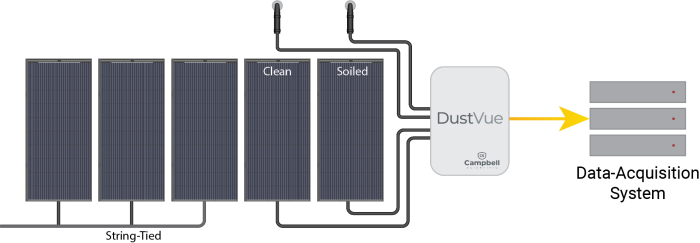How the DustVue Can Help You Get USABLE Soiling Data
par Ben Todt | Mis à jour le : 12/04/2023 | Commentaires : 0

Should you be concerned about the impact of soiling or fouling on your photovoltaic (PV) power plant performance? Did you know that in a recent estimate, more than US$6 billion of annual revenue is lost because of diminished power generation at PV facilities due to soiling or fouling of solar panel surfaces?
Solar power plant operators face the reality that the costs to mitigate soiling by cleaning a solar array are significant. Quantifying the power generation losses due to soiling and determining a cleaning and maintenance schedule for your solar arrays requires high‑quality data about soiling. Fortunately, at Campbell Scientific, we’ve designed the DustVue™ Solar-Module Soiling Sensor to help you make this critical, data-based decision.
Ease of Integration
We designed the DustVue to not only provide you with high-quality soiling-loss data, but the sensor is simple to integrate into your existing, regular maintenance activities. The following are some important components that make the DustVue easy for you to integrate:
- Built-in, in-situ calibration procedure
- Flexible mounting solutions
- Prewiring of sensor connections
- Direct-to-SCADA or met station integration
- Factory configuration (when information is provided to Campbell Scientific at the time of placing an order)
Four Things You Should Know
#1 - The most direct measurement of soiling loss possible
First and foremost, you should know that the DustVue uses one of the most well-researched and direct methodologies to measure soiling loss. It uses PV devices as sensors, preferably a production-size PV panel, to minimize impacts caused by mismatch due to spectral response, calibration, differences in dust characteristics such as size and color, and other complications introduced by less direct measurements.
This is the most direct measurement of soiling loss possible. An in-situ calibration procedure is included, and there is no other calibration requirement. In contrast, other methodologies (such as optical), require a calibration against a direct measurement such as the DustVue.
#2 - Rugged enclosure with flexible mounting options
The DustVue uses a standard Campbell Scientific enclosure for proven ruggedness and field reliability. To help you easily install the DustVue near the production panels used to make the soiling measurement, components are available to install the enclosure to an I-beam-shaped pile. Alternatively, for a different type of mounting option onsite, Campbell Scientific-compatible enclosure mounts are available:
- 19002 Enclosure Tripod Mast Mounting Kit
- 19017 Enclosure Tower Mounting Kit
- 27390 Enclosure Mounting Kit for 4 to 10 in. Tube
#3 - Prewired connections for easy connections
The DustVue provides you with prewired connectors for the required sensor connections. To help avoid having any problems with sensor wiring in the field, the solar panels utilized as sensors are connected to the DustVue using a cable prewired with MC4 connectors, allowing for simple attachment to the enclosure and the solar panels. Our state-of-the-art CS241 Pt-1000 Class A, Back-of-Module Temperature Sensor is prepared with rugged prewired connectors to make completing these connections quick and easy.
#4 - Employing existing infrastructure
Using the DustVue’s 16 to 32 Vdc power and an Ethernet connection, you can connect with your local met station or SCADA system, as shown in Figure 1. Because both setups are common at many solar power plants, the DustVue does not prescribe how this connection is made. There is space on the bottom of the enclosure for you to use your preferred conduit entry for power and Ethernet connections.

Because the DustVue needs to know the time and location to make its accurate measurements, the sensor can be factory configured for easy integration in the field. At the time your order is placed, simply provide the latitude, longitude, elevation, and network configuration information, and this metadata will be pre‑programmed to provide you with a simple plug-and-play solution for the sensor.
What You Can Expect
As a solar power plant operator, your most meaningful soiling-loss measurement will tell you how much of the sun’s available light is not reaching the PV panel’s power-producing solar cells. By making a direct measurement of the panel’s most stable and important parameter, the DustVue can provide this information to you reliably and accurately.
To receive good data from the DustVue, simply mark the reference panel as the clean panel and then clean it as part of the site’s routine maintenance schedule. However, in locations where soiling rates and losses are high, it might be beneficial to clean the reference panel more often if you would like to have finer time resolution in the soiling-loss data.
The DustVue provides a daily average soiling-loss value. A time history of that is shown in Figure 2, along with precipitation (which is not measured by the DustVue).

A Final Word
I hope you have found this information helpful and have a better understanding of how the DustVue Solar-Module Soiling Sensor can help you get usable, quantifiable data regarding your power generation losses due to soiling. With this data, you can then make informed decisions for your cleaning and maintenance schedule to maximize your facility's potential.
If you have any questions about whether the DustVue is suitable for your PV solar power plant, please contact your Renewable Energy sales engineer.




 Ben Todt is an application engineer in the Renewable Energy Group at Campbell Scientific, Inc. He specializes in working with customers to create robust and sustainable monitoring systems for photovoltaic solar monitoring systems. Ben has a masters degree in physics from Montana State University. In his free time, he enjoys biking and skiing.
Ben Todt is an application engineer in the Renewable Energy Group at Campbell Scientific, Inc. He specializes in working with customers to create robust and sustainable monitoring systems for photovoltaic solar monitoring systems. Ben has a masters degree in physics from Montana State University. In his free time, he enjoys biking and skiing.
Commentaires
Please log in or register to comment.